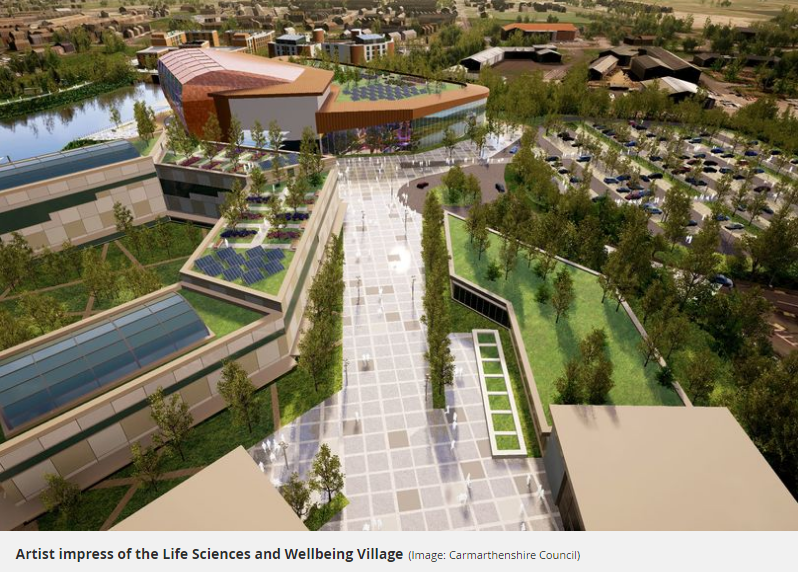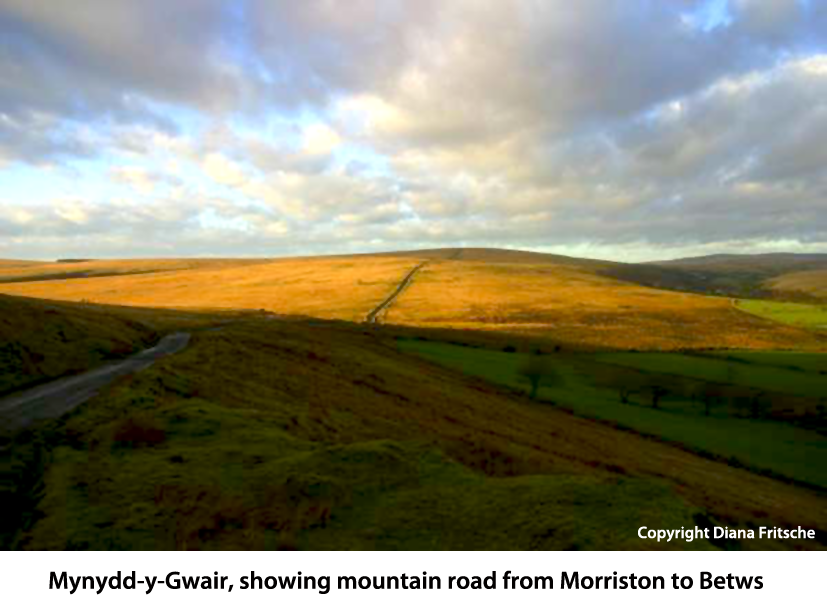As you can see, this is another big one. But it’s made up of five separate reports: Hendy wind farm, recent events in Swansea and Llanelli which may – or may not – be linked, the Bodnant Welsh Food Centre, the redevelopment of the Tower opencast site, and finally, the leadership election in a non-existent political party.
So you can either make yourself a panad, settle down and go through the lot in one go. Alternatively, you can take them one at a time. The choice is yours.
Unless something big crops up this might be my last posting until 2019. If that’s how it turns out, then . . .
◊
HENDY WIND FARM: WHO GAVE THE WORD? WHEN? WHY?
A few weeks ago, in Corruption in the Wind, I looked at three wind farms: Bryn Blaen, near Llangurig; Rhoscrowther, near Milford Haven; and Hendy, near Crossgates. All being promoted by the same property company.
Hendy wind farm merits another visit.
You’ll recall that Hendy was refused planning permission by Powys County Council and this decision was upheld by a planning inspector in May this year. But then, in late October, Lesley Griffiths, Energy, Planning and Rural Affairs Secretary for the management team in Cardiff docks, said that she would over-rule the planning inspector’s decision and allow Hendy to proceed.

In the earlier piece I argued that what triggered the change of heart over Hendy was the High Court decision in September to finally put a stop to the Rhoscrowther project on the Milford Haven Waterway.
Prior to that High Court decision the developers had Bryn Blaen in the bag, were hopeful of getting Rhoscrowther, and were probably resigned to writing off Hendy, taking the view that two out of three ain’t that bad. But once Rhoscrowther was lost they were down to one out of three – they had to have Hendy.
Here’s the sequence of events leading to where we are at present.
- 11.05.2018 Planning Inspector upholds Powys County Council decision to refuse planning permission for Hendy wind farm.
- 12.09.2018 High Court refuses leave to appeal on Rhoscrowther wind farm.
- 02.10.2018 Natural Resources Wales writes to Rhys Rigby of the Planning Inspectorate regarding appeal, “which was received on 19th September 2018.”
- 09.10.2018 Developer begins ‘pre-construction’ work at Hendy site. See Construction Environmental Management Plan (App to discharge cond. 21)
- 25.10.2018 Lesley Griffiths gives approval in letter to developer’s agents. (Though in that letter it was amusing to read, under ‘Timings & Plans’, “The development shall begin not later than five years from the date of this decision”.)
The Construction Environmental Management Plan we encountered in the bullet points above should have been produced before work started, but in the case of Hendy it’s dated November 19, six weeks after on-site work started.
The more I think about it, the more I believe there’s only one way to explain the panicky happenings at Hendy.
The decision to allow the Hendy wind farm was taken in London after approaches by the developers following the Rhoscrowther decision. (For despite the Planning Inspectorate having a desk in Cardiff it answers to the Department for Communities and Local Government in London.)
A political decision taken in London was passed to the Planning Inspectorate and only belatedly relayed to Lesley Griffiths when someone remembered about devolution. (Further proof that what masquerades as the ‘Welsh Government’ is just London’s management team in Wales.)
Worth mentioning may be that the landowner at Hendy is Sir Robert John Green-Price 5th Bt. It’s reasonable to assume that Sandhurst-educated Sir Robert has influential friends. It’s equally reasonable to assume that the developers, Marcus Owen Shepherd, Matthew Simon Weiner and Richard Upton, also ‘know people’.
Last week the developers were pile-driving at the source of the Edw, a Special Area of Conservation. All being done in the name of ‘conservation’ and ‘the environment’. The Edw runs south to join the Wye at Aberedw.

Where, last Sunday, a day after the Cilmeri commemoration, people remembered a hero who may have been betrayed. How fitting that they should gather at Aberedw, by a river being polluted by modern invaders assisted by today’s traitors.
◊
TIDAL LAGOON PUTTING WIND UP WIND FARMERS?
One of the more interesting schemes promoted in Wales in recent years was the Swansea Bay tidal lagoon. It eventually failed because the UK government refused to support it.
Yet it had a great deal of backing from people who pointed out that the electricity generated by the Swansea lagoon, a relatively small prototype, was bound to be expensive, but the possibilities of tidal power are immense and larger lagoons would be cheaper all round. For one thing tides, unlike wind, are entirely predictable and therefore reliable.
Not far away from the proposed tidal lagoon we saw one of the more extravagant schemes mooted in recent years in the £225m Wellness Village in Llanelli’s Delta swamp, being promoted chiefly by Carmarthenshire chief executive Mark James and Swansea academic Marc Clement, the latter a Turk by birth.

This project was to be part-funded from the £1.3bn Swansea Bay city deal.
Clement and a few other senior academics in Swansea, including the vice-chancellor, were recently suspended and it was generally agreed that this was somehow connected with the Wellness Village, certainly Clement was connected. Though no Llanelli connection could be established for vice-chancellor Richard B Davies or the other two, unnamed, persons who were suspended.
It was no surprise then that following the Swansea suspensions the Wellness Village seemed to get poorly. Within a very short time the infection spread and now a review has been ordered of the whole city region deal.
But why should the London government suddenly be so concerned about doings in south west Wales?
I’ve been giving this matter some thought, and here’s what I think.
Just a few miles from Swansea Bay lies Mynydd y Gwair, on the northern outskirts of the city. This was an area of wild and unspoilt upland . . . until fat grants were introduced for wind turbines.
Then the owner of Mynydd y Gwair, the Beaufort Estate (Prop. Duke of Beaufort), decided it could make millions by covering this beautiful area with ugly, useless, bird-killing wind turbines. This is the same Beaufort Estate that ten years ago charged the city council £280,000 to put a footbridge over the Tawe near the Liberty Stadium.

Beaufort and his ilk are descended from medieval robber barons, and they still know how to extract money from the rest of us.
It’s the same across this island. In Scotland the descendants of the Parcel of Rogues and assorted foreign landowners are minting it with wind turbines; while in England it’s a similar story, with former PM David Cameron’s father-in-law among those raking it in.
And linked with them are the property men and experts who will do all the dirty work, and reap their own rewards, those we see behind the Hendy wind farm.
And so there must be a possibility that the UK government is ‘reviewing’ the Swansea Bay city deal because Swansea council is threatening to resurrect the tidal lagoon, for that might be disastrous for the wind farmers who are so close to the Tory party, and in many instances, fund it.
‘But, Jac, what about the suspensions at Swansea University and the Wellness Village?’
The Wellness Village was up Shit Creek anyway, no private money was going to appear. It has simply been written off early before any more public money is wasted. As for the suspensions, the Wellness Village might have been a useful distraction.
Put the Wellness Village to one side and remember that the university is also heavily involved with Tidal Lagoon Mk II. It was the university that commissioned the recent report – on behalf of the Swansea Bay City Region – into reviving the barrage project.
Then look at the plan. Swansea University’s new Bay Campus is at the eastern landfall of the proposed lagoon. Students would have fought to get into a university with its own private beach which also overlooked a ground-breaking tidal lagoon offering many recreational facilities.

But as I say, a revived Swansea tidal lagoon might be bad news for those behind Hendy wind farm, and for Lord Beaufort, also for the repackaged Parcel of Rogues, and of course for Sam Cam’s daddy.
We may need to look no further to explain the UK government’s decision to ‘review’ the Swansea Bay city deal.
◊
BODNANT WELSH FOOD CENTRE
Another recent business failure was the collapse of the Bodnant Welsh Food Centre in Dyffryn Conwy. Though it now looks as though it has been saved by local teacake tycoon Richard Reynolds (who I’m sure is no relation to Rikki Reynolds of Weep for Wales notoriety).
In all the excitement too many have neglected to ask the basic questions about Bodnant, such as: Who’s calling the shots? Why was a grant of £6.5m made? Should that money have been allocated? Was the money used well? Why did Bodnant Food Centre collapse? What happens now?
The first thing to explain – and this is fundamental to understanding the bigger picture – is that the Bodnant Welsh Food Centre, opened in 2012 by Charles Windsor, is part of the Bodnant Estate, run by The Hon Michael Duncan McLaren QC, educated at Eton and Cambridge.
Michael McLaren’s father was the third Baron Aberconway, but this son has not succeeded to the title because he’s trumped by an older half-brother, Henry Charles McLaren, from his father’s first marriage (though there may be a dispute over entitlement).

You won’t find Bodnant Welsh Food Centre on the Companies House website because it trades as Furnace Farm Ltd, and this company was Incorporated with Companies House 20 October 2005. Furnace Farm is where we find the venture that received the £6.5m grant, but this is little more than a fancy shop selling overpriced food.
For as a source put it to me: “Dry home cured bacon for sale at £23/kg, yet both butchers at Llanrwst, some four miles away, were selling at £7.55/kg! Both butchers from known local sources!!”
Maybe at this point I should explain that despite not having succeeded to the title, Michael McLaren owns the whole shooting match, for in this document (page 5), the financial statement for year ending 31.01.2013, we read, “The company (Furnace Farm Ltd) entered into transactions with the Bodnant Estate which is owned by The Hon Michael McLaren”.
In addition to the Bodnant Estate and the Welsh Food Centre we have of course the well-known Bodnant Garden, owned by the National Trust but run by Michael McLaren as if he owns it. Then there’s Bodnant Garden Nursery Ltd, a private company with directors Michael McLaren, his wife Caroline, his mother, Lady Aberconwy, and Brian Eric Alcock.
The McLarens have three children: Angus John Melville, Iona Ann Mariel and Hamish Charles Duncan. Nice to see our Welsh aristocracy keeping with those names that resonate through our history.
Alcock’s background is in furniture, in north west England, with a previous directorship in Malbry Furniture (Sales) Ltd (wound up in May 1992), then Burford House Furniture Ltd (dissolved in August 2013).
So how did Alcock, with his IKEA-rivalling career in furniture, get involved with Michael McLaren in Bodnant Garden Nursery Ltd?
The other company in the family group is Bodnant Joinery Ltd, directors Michael and Caroline McLaren.
Giving us a number of interlinked enterprises on the Bodnant Estate, and all of them controlled by The Hon Michael McLaren QC. Invariably, with such an arrangement, there will be trading and lending between the different entities.
For example, that document I linked to earlier tells us that by January 2013 Furnace Farm Ltd owed Michael McLaren £4,969,122. By 31.01.2014 it’s up to £5,997,109. On 31.01.2015 it’s down a little to £5,862,901. A year later there is no specific mention of McLaren but the amount owed to all creditors has increased from £6,804,203 in 2015 to £7,921,963. By 2017 the figure is up to £8,981,591.
In that final financial statement we are also told that Furnace Farm Ltd lost before tax £1,497,444, up from £1,088,324 the previous year.
Just as well the company had a grant of £6.5m.
The problem with assessing how the grant was spent is that Furnace Farm Ltd is much more than just The Welsh Food Centre. For it also includes accommodation, at the farmhouse. In fact, the Estate offers plenty of accommodation.
And let’s not forget the National Beekeeping Centre of Wales.
To complicate the picture further, when I went to the Welsh European Funding Office (WEFO) website I could find nothing for either Furnace Farm Ltd or Bodnant Welsh Food Centre.
So eventually I telephoned WEFO, and I was surprised to learn that the name of the project was in fact the Centre of Excellence for Welsh Food, a name I have not seen used.(But I am only too familiar with this practice for making it difficult to make enquiries.) Here are the details.
So the question becomes – on what was the £6,444,107 spent? And after going back to WEFO I was told that, “Furnace Farm Ltd received funding of £237,032 from the Processing and Marketing Grant scheme . . . enabled the company to erect a new bespoke building complex . . . “.
So that’s £6,681,139, and counting?
The document I’ve linked to reads: “Centre of Excellence for Welsh Food The adaptation of abandoned farm buildings for economic use . . . 5 minutes from the A55 . . . private investor is providing 50% of the costs . . . project aims to create a retail outlet for local products, catering facilities for innovation with local food and a culinary school.”

The mention of “abandoned farm buildings” being adapted “for economic use” may refer to the farmhouse I mentioned earlier, now being used as a holiday let, rather than having anything to do with food excellence.
The latest update tells us that the new owner of the food centre, who plans to re-open on February 1st, and is said to be leasing the buildings from the McLarens, told the Daily Post: “It (Bodnant Welsh Food Centre) has been poorly run and we want to bring it back to what it was . . . with genuine authentic local produce in the shop . . . We can’t get away with charging a premium for something you can pick up in the supermarket.”
How very true. But then, if civil servants and/or politicians want to give someone millions of pounds to spend on property he already owns, then whether a retail outlet succeeds or not may be of little consequence in the bigger scheme of things.
The big question for me is: Why did anyone think it was a good use of EU funding to give millions of pounds to a wealthy aristocrat to open a London-prices shop in the Conwy Valley, especially as such funding was not supposed to be given for retail purposes?
And what guarantees do we have that such ‘misjudgements’ will never occur again?
◊
THE LEFT BETRAYS WALES, AGAIN
This is another little tale that gets rather complicated, so let me set the scene with some background information. (Sorry, no music.)
You’ll recall that in December 1994, under threat of closure, Tower Colliery at Hirwaun was bought out by its miners under the leadership of Tyrone O’Sullivan. This made them mine-owners but paradoxically they also became deities in the socialist pantheon.
Tower Colliery was worked until it became uneconomic and closed in January 2008. What is less well known is that following the closure there was a period of opencast mining in the area.
This explains the formation of Tower Newco Ltd which soon changed its name to Tower Regeneration Ltd, a company dedicated to, “Open cast coal working” and “Development of building projects”. The second of those presumably following the ensuing clean-up operations.
Opencast mining began in May 2012, and if it hasn’t already ended, it is scheduled to end this month.
At its birth, Tower Newco Ltd had a single director named on the Certificate of Incorporation, a Kevin Dougan, of Durham. He was soon joined by others including O’Sullivan and also by Ian Anthony Charles Parkin, another businessman from north east England.
If we turn to the Tower Regeneration website, and scroll down to the bottom we find a link to a company called Hargreaves. It’s no surprise to learn that Hargreaves Services plc is also based in Durham, and among its directors we find Kevin James Stewart Dougan.
Almost immediately it was set up Tower Regeneration Ltd took out a loan with Forward Sound Ltd, of Durham, a company that had been set up less than a year before Tower Regeneration. In fact, it’s difficult to escape the conclusion that Forward Sound was set up specifically to capitalise on the Tower opencast project.

Why the strong Durham connection? Well, on a practical level it was a coal-mining area, but on the emotional plane Durham to the bruvvers means the annual Miners’ Gala; it conjures up images of comradely solidarity, fluttering banners and fiery speeches.
On 1 December 2017 the ubiquitous Dougan ceased to be a director at Hargreaves Services, Tower Regeneration, and Forward Sound, but rejoined Tower Regeneration the very next day . . . though Companies House wasn’t notified until 27 April this year!
So from the outset, the Tower opencast and regeneration project has been funded and controlled by English interests. And now they’re lining up to get their hands on the money available for ‘restoration’ work. And we are talking many millions of pounds here.
And as might be expected, the English Labour Party in Wales is eager to play its allotted role in short-changing Wales, again.
It seems that the prettying up is to be done by The Land Restoration Trust, which is both a charity (No 1138337) and a company, though for some reason, on its website it’s called The Land Trust. Its headquarters are in Warrington and it specialises in “open space for community benefit”, much of that open space seems to be reclaimed industrial land, especially in former coalfields.
The Land Restoration Trust was set up by the Coalfields and Joint Ventures Division of the now defunct English Partnerships, “the national regeneration agency for England”, which was succeeded in December 2008 by the Homes and Communities Agency, since re-named Homes England.
Clearly the Land Restoration Trust is an England-only body. Though the website has pages for Scotland and Wales both read: “We currently do not manage any sites in (Scotland/Wales) although we are working hard to do so. If you would like discuss any potential opportunities please contact our Business Development team.”
Despite having no sites in Wales Alison Whitehead, described as ‘Development Manager’, enjoys visiting sites in Wales! But then, Alison, as her Linkedin profile tells us, was ‘Development Manager for North of England and North Wales’.
On 31 January 2018 a reception was held for the ‘Land Trust’ at the Senedd. It was hosted by Vikki Howells the Labour AM for Cynon Valley. Here’s the report from the Land Restoration Trust website.
And below you’ll see what Howells put out on Facebook the following day. Note that she mentions “ownership and management options”. In fact, it had already been decided behind the scenes, and years ago, making the Senedd reception no more than a PR exercise.

Vikki Howells is involved for no better reason than she’s the local AM, having been elected in 2016 because she was the donkey with the red rosette. Does she really understand what’s gone on at Tower and who owns what?
Though if Ms Howells was so keen to inform the Cynon Valley public then she should have explained why her administration has abrogated its responsibilities and rolled back devolution. And also explained why the profits from developing this local site will be leaving Wales.
The Tower opencast operation didn’t last for much more than six years, it employed few, and when repayment of loans, leasing and hiring are taken into account, it wasn’t that profitable, certainly not for Tower. The big beneficiary appears to have been Hargreaves Surface Mining Ltd, renamed Hargreaves Land Ltd in June 2018.
(It should go without saying that Kevin James Stewart Dougan ceased to be a director of Hargreaves Land on 1 December 2017. What is the significance of that date?)
Hargreaves Surface Mining was set up in October 2011, just before opencast mining began at Tower. The timing is no coincidence. Hargreaves Surface Mining Ltd joined a host of new companies that had been created in north east England to make big bucks out of a mining operation in Wales.
An operation that put little money into the local economy but enriched strangers. It also served the purpose of being the necessary precursor to the second stage of the project that will inherit a large tract of land together with millions of pounds to landscape and redevelop it.
Who knows what will be done on the old Tower opencast site. Housing? A leisure resort such as we see not far away in the Afan Valley? One thing I predict with certainty – as with the opencast site, the profits will leave Wales.
Vikki Howells seems to envision the development at Tower linking with the Rhondda Tunnel . . . owned by Highways England!

Or maybe it’ll be more wind turbines, for while they generate little or no electricity they certainly produce massive incomes for those who operate them, and the landowners involved.
It’s difficult to believe that all this is happening after twenty years of devolution. But as I’ve argued many times, devolution is a sham, a façade; and behind that façade Wales is being ripped off and inexorably assimilated into England.
This assimilation along with the exploitation we see at Hendy and Mynydd y Gwair, Bodnant and Tower, is being facilitated by socialists, and the Labour Party, doing what they always do – selling Wales down the river.
◊
GREEN PARTY OF ENGLANDANDWALES
Earlier this year members of the self-styled ‘Wales Green Party’ voted against becoming a Wales Green Party, choosing to remain part of the Green Party of Englandandwales and calling themselves The Green Party in Wales. Whereupon the party ‘leader’ defected to Plaid Cymru.
The confusion that resulted may be reflected in the fact that the party website seems to have been abandoned, with nothing posted since 10 July.

Yet despite all the recent tribulations this Green Party of England in Wales is currently holding a leadership election. Yes, that’s a leadership contest to a non-existent party! Among those standing is Anthony Slaughter.
So who is he? Well, it should go without saying that he’s not Welsh. He lives in Penarth and seems to have a high regard for himself, adopting that tone of moral and intellectual superiority that so endears the Greens to me.

And he spreads his talents wide, for when he’s not saving the planet he’s up in London demanding something called A People’s Vote, supporting the Stansted 15, and arguing for 20 mph speed limits. Sainthood can’t be far away.
But being a Green he’s probably a practising pagan. (Or am I thinking, vegan?)
Obviously there’s no such thing as the Wales Green Party, but then, there’s no such thing as the Welsh Labour Party either, it’s just a label, there’s nothing registered with the Electoral Commission.
So maybe the Greens take their lead from the Labour Party, because they often seem close, almost as if the Greens are the idealistic younger relative indulged by the more staid Labour Party.
And the closeness isn’t confined to the Greens, it seems to extend to the environmentalist movement as a whole, maybe it’s something to do with the self-absorbed regarding themselves as ‘progressive’
This perhaps explains why public money was recently spent on foot massage by the Future Generations Commissioner, that very close friend of the late Carl Sargeant.

But it’s not just Labour that likes to cwtch up to those who think that the examples of Hendy and Mynydd y Gwair should be replicated on every pristine landscape in Wales. Who believe that carving up the countryside to lay thousands of tons of concrete is good environmental practice.
I mentioned that Slaughter, the would-be leader of the non-existent party, lives in Penarth. Where I’m told certain Plaidistas – the names Clubb and Wilton were mentioned – have been keen to do electoral deals with these Wales-rejecting colonialists.
But then, nothing surprises me any more, whether it’s the Greens, Plaid Cymru, or the Labour Party. They all pursue their own agendas, driven by narrow ideology and trapped within dogmas, rather than pragmatically promoting what’s best for the Welsh people.
That’s why they’ve failed us, and that’s why time is running out for all of them.
♦ end ♦


























